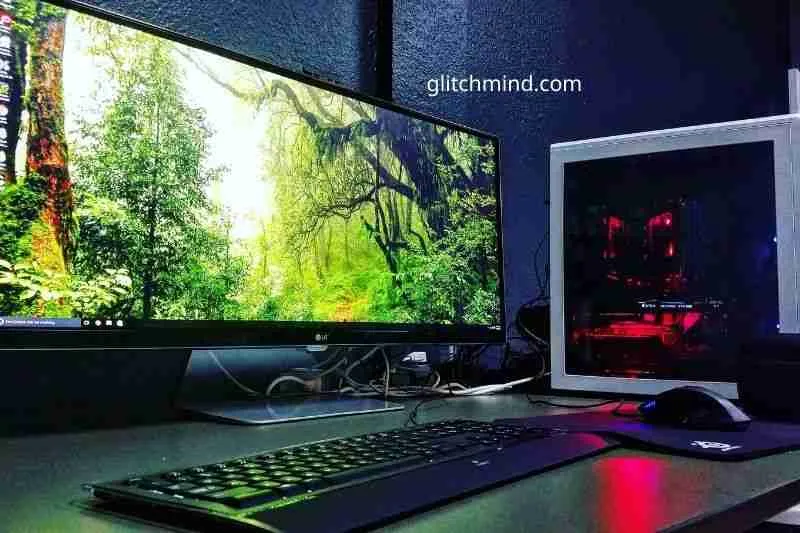If you’re in the market for a new computer monitor, you may be wondering if can you use a TV as a computer monitor. The answer is yes, you can use a TV as a computer monitor, but there are a few things you need to keep in mind.
In the following article, Glitchmind will help you answer this question and the notes attached to it.
Can you use a TV as a computer monitor or tv?
Yes. Yes. TVs have been used as monitors by people since the invention of the home computer. Both TV and computer screens have used the same technologies throughout the years. These technologies range from vacuum tubes to LCD technology. Most TVs today support Wi-Fi or HDMI, which allows them to connect wirelessly with your computer or via an HDMI cable.
Things to consider before you replace your TV’s monitor with a TV
1. Color Compression
You can expect a slight decrease in picture quality when using TV as a monitor. This is because the TV compresses images or texts.
The change should not be significant if your TV is high up on the wall. However, if the TV is placed in front of your desk like a standard monitor, blurriness and poor picture quality will be more apparent.
You can change the picture settings on most modern TVs to 4/4:4 and fix this problem. You can also search for TVs that have 4:4:4 subsampling if you are still looking for one.
2. Response time
The time it takes for colors to change on your screen’s pixels to respond is called the response time.
Computer monitors have faster response times than TVs. However, if you purchase HDTVs with a game mode setting, this should not be a problem anymore. The TV’s response time should increase dramatically once you have chosen this setting. However, the price of this set is much higher than that of the monitor.

3. Refresh Rate
The refresh rate refers to the number of times a display “refreshes” the image every second.
It is common for TVs and monitors to have a very different refresh rate. Computer monitors can display refresh rates as high as 240Hz, while TVs are limited to 60Hz-120Hz.
When it comes to editing or gaming, the screen’s refresh rate is critical in how responsive it will be. For most applications, 120Hz should suffice.
4. Input Lag
Input lag refers to the time delay between movements made on your input device (in our case, a keyboard and mouse) and what is displayed on your screen. Most computer monitors have a minimum lag time, but HDTVs are more concerned with video processing. Although these extra milliseconds might not seem important, they can make a huge difference in competitive online gaming.
DisplayLag keeps a database of input lag times sorted by display type. If you use the HDTV as an HDTV, an input lag of 30 milliseconds or less is acceptable. You should aim for less than 20ms input lag when using a computer monitor. The lower the number, the better.
5. Resolution and Pixel Density
The resolution refers to your screen’s dimensions in pixels. While the pixel density is the number per inch (PPI), These details are crucial if you choose to use a giant TV as your computer monitor.
If you compare a 27-inch LCD monitor to a 40 inch TV, you might be surprised at the difference in resolution. However, the computer monitor has a pixel density of 140ppi, while the TV’s is only 40ppi.
This is because the screen with a lower pixel density will produce images that aren’t as clear or sharp as those with higher pixel densities.
This is because TVs often have low pixels per inch density. The viewer does not need to be close to the TV but can view it far away. Computer monitors have a higher pixel density because the user is closer to the screen.
6. Keep these HDTV features in mind
These considerations are instrumental if you plan to replace your small computer monitor with an HDTV. Using an HDTV will cause you headaches or eye strain.
These factors may not be necessary if the TV is positioned several feet from your desk or hung on the wall.

How to use a TV as a monitor wirelessly?
A smart TV is an excellent choice for computer monitors in 2019. The cables are not necessary. You’ve longed for connector cables to disappear and leave your floors free from tripping hazards. Chromecast, Roku, and other casting or streaming devices solve the TV as computer monitor problem in Tony Stark levels of style.
First, choose a streaming device. There are many options, including Roku and Google Chromecast. These flash drive-style dongles or sticks plug into the HDMI port of a TV.
Pro tip: The major streaming devices come in 3K and 4K versions. The 4K model is the best. While the 3K units are acceptable for video, they won’t work well when used as a monitor on a TV. The 3K streaming unit can cause bottlenecks and reduce image quality.
Once you have chosen a casting device, connect it to your TV’s HDMI port. Although it takes a few minutes to set up, anyone can install an application in a matter of minutes.
Use a TV Tuner with Your Monitor
A TV tuner is required to connect an antenna or cable signal to your monitor. A TV tuner can decode and convert the signal into a picture.
All televisions made after 2006 must have a built-in TV tuner. This converts the antenna or cable signal into audio and video. This allows you directly to connect an antenna or cable to your TV without the need for an external TV tuner.
Computer monitors don’t come with integrated tuners. Next, we will explore using a computer monitor as a TV using a Set Top Box/Tuner.
First, let me offer an alternative. This is my solution, and it’s a lot more convenient. An Amazon Fire Stick is all I need to watch any content I choose without the use of cables or TV tuners. If you will, the Fire Stick is my 21st Century Set Top Box. This is all you have to do to connect it to the HDMI port on your monitor.
Most households have at least one Fire Stick. They can support multiple subscriptions such as Netflix, Hulu, and Amazon Prime. A subscription to any of these services is far less expensive than cable.
FAQs
1. What is the difference between HDR & 4K?
HDR and 4K are not comparable standards. HDR (High Dynamic Range) refers only to the screen resolution. 4K is the contrast between the darkest and lightest tones within an image.
2. Is it OK to use a 4K TV as a Monitor?
All 4K TVs can be connected to your TV via HDMI or DisplayPort. However, a 4K TV will not display your desktop in Ultra HD unless it has a compatible port.
You can also mirror your screen wirelessly using a mobile device or computer. You will need a wired connection to take full advantage of 4K.
3. How can I clean my 4K TV screen?
Please turn off your flat-screen TV and wipe it clean with a soft, dry cloth. Use distilled water to dampen the fabric or a mixture of white vinegar and distilled water pliable.
Related posts:
Conclusion
A TV can be used as a computer monitor, but it is not recommended. A TV is not designed to work as a computer monitor and may have problems displaying certain images or colors correctly.
